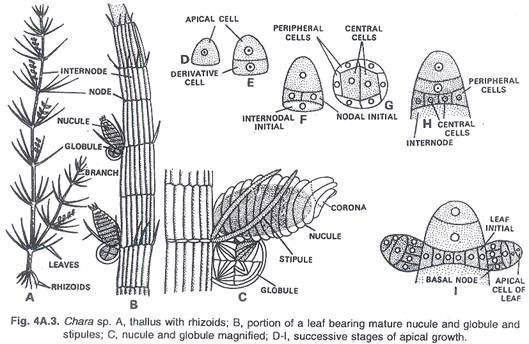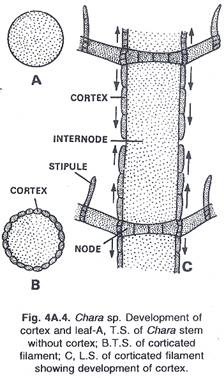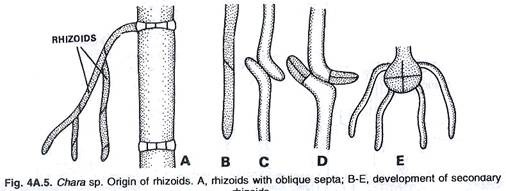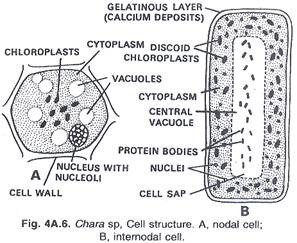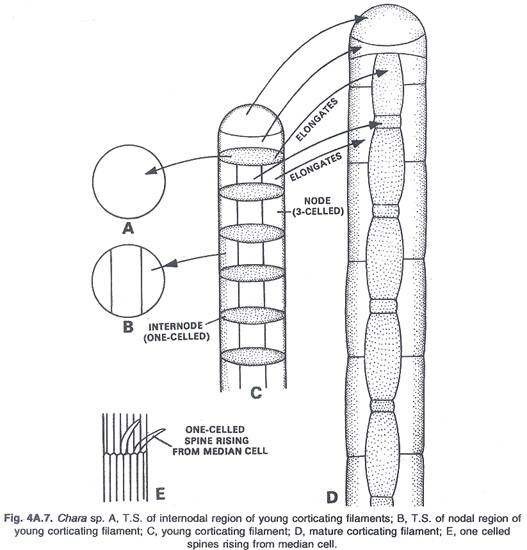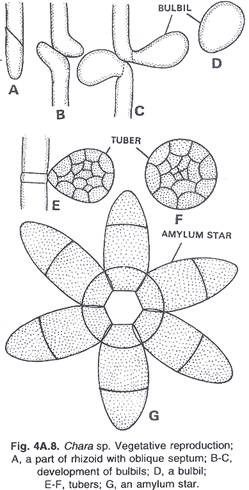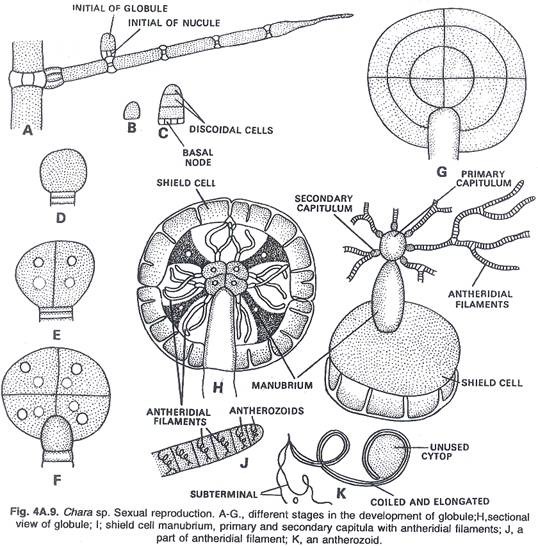ADVERTISEMENTS:
In this article we will discuss about the vegetative and sexual modes of reproduction in Anthoceros with the help of diagrams.
Vegetative Reproduction in Anthoceros:
Vegetative Propagation takes Place by the following Four Methods:
(a) By Progressive Death and Decay of the Older Parts of the Thallus (Fragmentation):
ADVERTISEMENTS:
Vegetative reproduction often rakes place by the decay of the older basal parts of the thallus and by continuous growth from the growing point. The tip grows continuously giving rise to separate plants. This method is’ less common in Anthoceros than in other Hepatics.
(b) By Tubers:
Under unfavourable environmental conditions like prolonged drought, many species of Anthoceros (e.g. A. laevis, A. tuberosus, A. pear- soni, A hallii) produce tubers on the marginal patches of the thallus tissue (Fig. 6.29 E).
Tubers escape from desiccation with the formation of a resistant layer of cork cells. Tubers store food and function as perennating organ that germinate into new gametophytes on the return of favourable environmental conditions.
ADVERTISEMENTS:
(c) By Gemmae:
Gemmae are known to develop on.the dorsal surface of the thallus in some species of Anthoceros (A. gladulosus, A. formosii, A. propaguliferous). They are stalked and often develop mucilage pores. On separation from the parent plant, the detached gemmae grow into a new gametophyte.
(d) By Persistent Growing Apices:
During dry summer, the thalli of some species of Anthoceros (e.g., A. pearsoni and A. fusiformis) become completely dry except the apical region with a little of adjacent tissue. These apical parts remain dormant during the dry season and form new thalli on the return of favourable conditions.
Sexual Reproduction in Anthoceros:
Anthoceros is either dioecious i.e., hetero- thallic (e.g., A. himalayensis, A. hallii, A erectus, A. pearsoni) or monoecious i.e., homothallic (e.g., A. fusiformis, A. gollani, A. punctatus). Monoecious species are usually protandrous i.e., antheridia mature before archegonia. Antheridia and archegonia are embedded in the dorsal surface of the thallus. They develop in continuous rows just behind the apical growing point.
Antheridium:
Development and Structure of Antheridium:
In the species of Anthoceros, the antheridium develops from a hypodermal cell as opposed to liverworts. A superficial dorsal cell, lying close to the growing apex, usually divides by a periclinal wall into an upper roof initial and a lower antheridial initial (Fig. 6.32A-B). The upper roof initial first divides periclinally, followed by many anticlinal divisions to form a multi-celled roof over the antheridium.
ADVERTISEMENTS:
The antheridial initial is, therefore, hypodermal rather than superficial (Fig. 6.32B). The cavity between the roof initial and the antheridial initial accumulates mucilage. Subsequently, this cavity enlarges to form a antheridial chamber (Fig. 6.31). The antheridial initial may develop a single antheridium (e.g., A. pearsoni) or may divide to form several antheridia. (e.g., 7 in A. crispulus, 22 in A. erectus, 30 in A. gemmulosus).
Sometimes, younger antheridia also develop from the base of the older antheridium resulting into the development of a cluster of antheridia of different ages in a single antheridial cavity (Fig. 6.31). Just prior to the division, the antheridial initial becomes almost superficial. The antheridial initial undergoes two vertical divisions at right angle to each other forming four cells.
This is followed by a transverse division resulting in eight cells, arranged in two tiers of four cell each (Fig. 6.32C-F). The cells of the lower tier are known as stalk cells, while the cells of the upper tier are called antheridial cells. The basal stalk cells by transverse divisions form the stalk of .the antheridium (Fig. 6.32G).
The upper antheridial cells divide transversely to form a 8-celled ottant. Each cell of the octant by periclinal division form eight outer primary jacket cells and eight inner primary androgonial cells (Fig. 6.32F-G).
ADVERTISEMENTS:
The primary jacket cells divide anticlinally to form a single layer jacket of antheridium. The primary androgonial cells undergo many regular divisions resulting into the development of a mass of androcyte mother cells.
Subsequently, each androcyte mother cell divides to form two androcytes. The androcytes get metamorphosed into biflagellate antherozoids very soon (Fig. 6.32H). A mature antheridium now consists of a slender stalk and a club-shaped or pouch-like body (Fig. 6.31). The club-shaped body has a single-layered jacket which encloses a number of biflagellate antherozoids (Fig. 6.32H).
Dehiscence:
ADVERTISEMENTS:
At maturity, the roof of the antheridial chamber ruptures, exposing the antheridia. The apical cell of the antheridial wall, on absorbing water, ruptures by apical aperture. The antherozoids are now liberated to the covering film of water.
Archegonium:
Development and Structure of Archegonium:
The archegonia produce in acropetal sequence on dorsal surface of the thallus. The archegonia develop from a single superficial dorsal cell close to the apical growing point. In monoecious species, the archegonia are formed later in the same thallus which had borne the antheridia (A. fusiformis, A. gollani, A. punctatus).
ADVERTISEMENTS:
The archegonial initial (Fig. 6.33 A), by transverse division, gives rise to an outer primary archegonial cell and an inner primary stalk cell. But according to Mehra and Handoo (1953) the archegonial initial functions directly as the primary archegortial cell.
There is no stalk cell. The primary archegonial cell by three transecting periclinal divisions forms three outer jacket initial cells and an inner primary axial cell (Fig. 6.33B & C).
The primary axial cell, by transverse division, (Fig. 6.33D) forms two cells, the lower primary ventral cell and the upper cell which further divides transversely to form a top cover initial and a lower primary neck canal cell (Fig. 6.33E).
The cover initial divides by two vertical walls at right angle to each other forming a rosette of four cover cells. The primary neck canal cell by repeated transverse divisions forms a vertical row of 4 to 6 or more neck canal cells. The primary ventral cell, by transverse division, forms the ventral canal cell and a large egg (Fig. 6.33F).
The Mature Archegonium:
The mature archegonia remain completely embedded in the dossal surface of the gametophyte except the cover cells that protrude slightly above the surface of the thallus. In the growing archegonium, the cover cells are usually associated with a mucilage mound (Fig. 6.33G).
ADVERTISEMENTS:
Fertilisation of Archegonium:
At the time of fertilisation, the cover cells are thrown off, followed by the disintegration of the neck canal cell and the ventral cell. The egg now becomes directly exposed resulting into the formation of mucilaginous mass. Among the many antherozoids entering the neck, only one fuses with the egg and forms the zygote or oospore.
The Sporophyte:
Development of the Sporophyte:
The diploid zygote (fertilised egg) is the mother cell of the sporophytic generation. It increases in size and secretes a wall of cellulose around itself and eventually becomes 4-celled by two successive divisions at right angles to each other (Fig. 6.34A).
A second vertical division, at right angle to the first one, forms an eight-celled embryo, the octant, composed of two tiers of 4 cells each. The capsule is formed from the cells of the upper two tiers.
The lower tier of four cells, after repeated divisions, forms the sterile bulbous foot. Short rhizoid-like projections develop from the lowermost cells of the foot, thus they increase the absorptive surface for absorption of nutrients from the gametophyte.
The upper tier of cells divides and its lower cells develop an intercalary meristematic tissue. The upper cells of the upper tier divides periclinally to give rise to the inner endothecium and the outer amphithecium (Fig. 6.34B).
The endothecium forms the central sterile part of the capsule, the columella (Fig. 6.34C and 6.35A), composed of sixteen vertical rows of cells (Fig. 6.35B). The second periclinal division of the amphithecium gives rise to an outer sterile layer of jacket initials and an inner fertile layer of sporogenous cells.
Formation of the Jacket:
The jacket initial divides both anticlinally and periclinally to form a 4- to 6-layered thick jacket in the mature capsule (Fig. 6.35A and B). The outermost layer of the jacket becomes an epidermis with cutinised outer walls. The outer layer (epidermis) of jacket is provided with stomata, while the cells of inner layer are parenchymatous, contain chloroplasts, hence photosynthetic.
Formation of Spore:
The sporogenous cells later form the archesporium (Fig. 6.34C) which may extend up to 4 layers in thickness. In some species (e.g., A. crispulus, A.erectus), the archesporium remains single layered. The archesporial cell matures in basipetal sequence i.e. the apical cells mature earlier than the basal cells.
Alternate transverse tiers of the archesporium differentiates into spore mother cells and sterile cells. The spore mother cells are large, spherical or oval with dense cytoplasm and larger nucleus which divide meiotically to form the spore tetrads (Fig. 6.35A, B). The sterile cells join end to end forming simple or branched 3- to 5-celled pseudoelaters which do not have any thickened bands (Fig. 6.35A, B).
Structure of the Mature Sporophyte:
The mature sporophytes are cylindrical and straight, rarely slightly curved structure, usually grow in clusters from the dorsal surface of the thallus. The sporophyte appears like horns which project out 2-15 cm in some cases, hence the plants are commonly known as ‘hornworts’.
When young they are green in colour, but they gradually turn black or dark yellow during maturity from the tip to the base. At the base, the capsule is surrounded by a tubular sheath, the involucre (Fig. 6.35A). It is an outgrowth of the thallus and thus is a gametophytic tissue. It is protective in function and also gives support to the weak intercalary zone.
The sporophyte is differentiated into three regions:
(i) The lower bulbous foot,
(ii) The intermediate meristematic zone, and
(iii) The upper erect, cylindrical capsule (Fig. 6.35A). The seta is absent.
The Foot:
It is the basal part of the sporophyte which is a rounded bulbous structure deeply embedded in the tissue of the thallus (Fig. 6.35A). The lowermost cells of the foot are haustorial which absorb water and mineral nutrients from the gametophyte for the developing sporophyte.
The Intermediate Meristematic Zone:
This is a narrow zone of meristematic cells located in-between the foot and the capsule {Fig. 6.35A). It regenerates the capsule from the base, thus the capsules are always in different stages of growth.
The Capsule:
The capsule forms the major and conspicuous part of the sporophyte. It is a slender smooth upright cylindrical structure that slightly tapers at the apex. It consists of capsule wall, sporogenous tissue and collumela (Fig. 6.35A).
Capsule Wall:
The capsule wall is made up of 4-6 layers of parenchymatous cells. The cells of the outermost layer, which form the epidermis, are heavily cutinised, vertically elongated and interrupted by the stomata (Fig. 6.35C). Below the epidermal layer is the green parenchymatous, photosynthetic tissue containing chloroplasts.
Thus, the sporophyte is capable of manufacturing their own food by photosynthesis, except for the water and minerals for which it depends upon the gametophyte.
Sporogenous Tissue:
The sporogenous tissue (archesporium) of Anthoceros is situated in between the jacket and the collumela. At maturity it differentiates into spore mother cells and pseudoelaters.
Columella:
The columella is a solid column of sterile tissue situated at the central part of the capsule. It extends nearly to the entire length. The cells are narrow and elongated and are arranged in 16 vertical rows.
In transverse section, the columella appears to be a solid square (Fig. 6.35B). The columella provides mechanical support to the capsule. It also helps the spores to disperse and is associated with the conduction of water and minerals.
Dehiscence of the Capsule:
At maturity, the tip of the capsule loses water. In fact, the loss of water from the capsule walls greatly favours the dehiscence. After drying of the capsule, a split appears just below the tip which gradually widens downwards and eventually the capsule wall splits into two to four valves.
The hygroscopic movement of the pseudoelaters releases the spores to a distance by air current and at this stage the apical portion of the capsule looks twisted. The tip of the collumela projects out like a flagellum. (Fig. 6.35D).
The New Gametophyte:
The haploid spore is the first cell of the gametophytic generation. The wall of the spore is differentiated into an outer thick sculptured exine (exospore) and an inner thin and smooth intine (endospore) (Fig. 6.36A).
The spore germinates on a suitable substratum either immediately or after a resting period of a few weeks to a few months. The exine rupture through the triradiate ridge and the intine comes out as a long germ tube (Fig. 6.36B). All contents of the spore passes to the germ tube.
Here two cells are produced at the tip of the germ tube through two successive transverse divisions. This is followed by two vertical divisions at right angle to each other resulting into the formation of 8-celled octant or sporeling. The four distal cells of the octant become meristematic and differentiate into a new gametophytic thallus.
Fig. 6.37 shows the diagrammatic life cycle pattern of Anthoceros.
Anthocerotophytes are a distinct but synthetic group of plants:
The phyllum Anthocerotophyta has been called a synthetic group as, apparently, it shows characteristics linking it to the algae on one hand and to other groups of embryophyta.
Characteristics common with algae:
1. Simple, green thallus-like plant body and its branching.
2. Presence of a single chloroplast with pyronoids in each cell of the thallus.
3. Biflagellate antherozoids with whiplash flagella.
Characteristics common with liverworts (Marchantiophyta):
1. Apical growth of the thallus taking place by a single pyramidal apical cell with four cutting faces.
2. Gametophytic structure (thallus) resembles Pellia (liverwort). In both the members, scales and tuberculate rhizoids are absent.
3. Similarity in the construction of mature sex organs.
4. Separation of amphithecium and endothecium by periclinal divisions.
5. Archesporium gives rise to spores and sterile cells (pseudoelaters). In Dendroceros and Megaceros, elaters possess spiral bands as in liverworts.
6. In some species of Notothylus (N. levieri) whole endothecium giving rise to archesporium and the amphithecium forming the jacket of capsule. This suggests a connecting link between hornworts and liverworts.
Characteristics common with mosses (Bryophyta):
1. Presence of central columella in the capsule which develops from the endothecium.
2. The sporogenous tissue is greatly reduced.
3. Presence of functional stomata in the capsule wall as in Funaria which provides a ventilated photosynthetic system.
4. Archesporium differentiates from the inner layer of amphithecium as in Sphagnales.
Characteristics common with Pteridophytes:
1. General similarity in the thallus structure of Anthoceros and the fern gametophyte (prothallus).
2. The sex organs are embedded (sunken) in the thallus.
3. Similarity in the structure of mature archegonium.
4. Highly developed semi-parasitic sporophyte of indeterminate growth showing photosynthetic capsule wall with functional stomata.
The elaborate, semi-parasitic sporophyte of Anthoceros with its typically ventilated assimilatory system and indeterminate growth denotes the nearest alliance to the independent rootless, leafless, dichotomously branched sporophyte of the primitive vascular plants the Rhyniopsida.
The features of Anthocerotophytes that are common with lower group of plants, i.e., algae, and the higher groups of plants, like liverworts, mosses and pteridophytes, suggest that the Anthocerotophytes are a distinct but synthetic group of plants.

